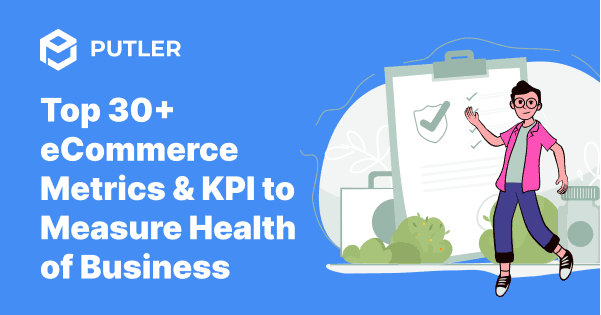“If you can’t explain an eCommerce metric in terms of dollars gained, it’s probably not worth tracking.” That’s what I learned after years helping online stores grow.
This guide cuts through the analytics noise to reveal the only eCommerce metrics worth your attention, plus simple ways to improve each one.
Your dashboard’s about to get smaller, and your revenue’s about to get bigger.
Without further ado, let’s get started.
Build foundation
Before diving into the metrics, let’s build a solid foundation first.
What are eCommerce metrics?
eCommerce metrics are specific, measurable values that track the performance of your online store in key areas like sales, marketing, customer behavior, and inventory.
For example, looking at raw numbers might tell you “we had 250 sales this week,” but metrics show you’re converting at 1.2% when competitors average 3.5%, revealing a huge opportunity to improve your product pages.
How metrics differ from data points
Data points are isolated facts without context. Metrics combine these facts into measurements that tell a meaningful story about your business performance.
Seeing “150 new email subscribers” might seem impressive, but the metric reveals this came from 15,000 visitors—a 1% signup rate.
Now you know your popup isn’t working, rather than mistakenly thinking your list-building is on track.
Metrics vs. KPIs: What’s the difference?
Metrics are all the numbers you can track in your business. KPIs are the vital few metrics directly connected to your most important business goals.
You might track 25 different metrics in your dashboard, but your three eCommerce KPIs, customer acquisition cost, average order value, and customer lifetime value, are the ones you obsess over.
Why? because they directly indicate if you’ll hit your revenue targets.
How and when a metric becomes a KPI?
A metric graduates to KPI status when you identify it as critical to your specific business objectives and begin using it to drive decisions and measure success.
Your 62% cart abandonment rate was just another metric until you realized reducing it by just 10% would add $120,000 in annual revenue.
Now it’s your top KPI with weekly team meetings focused solely on improving this number.
To build a strong foundation and increase the knowledge base further, read eCommerce analytics 101.
Sales and Revenue eCommerce metrics
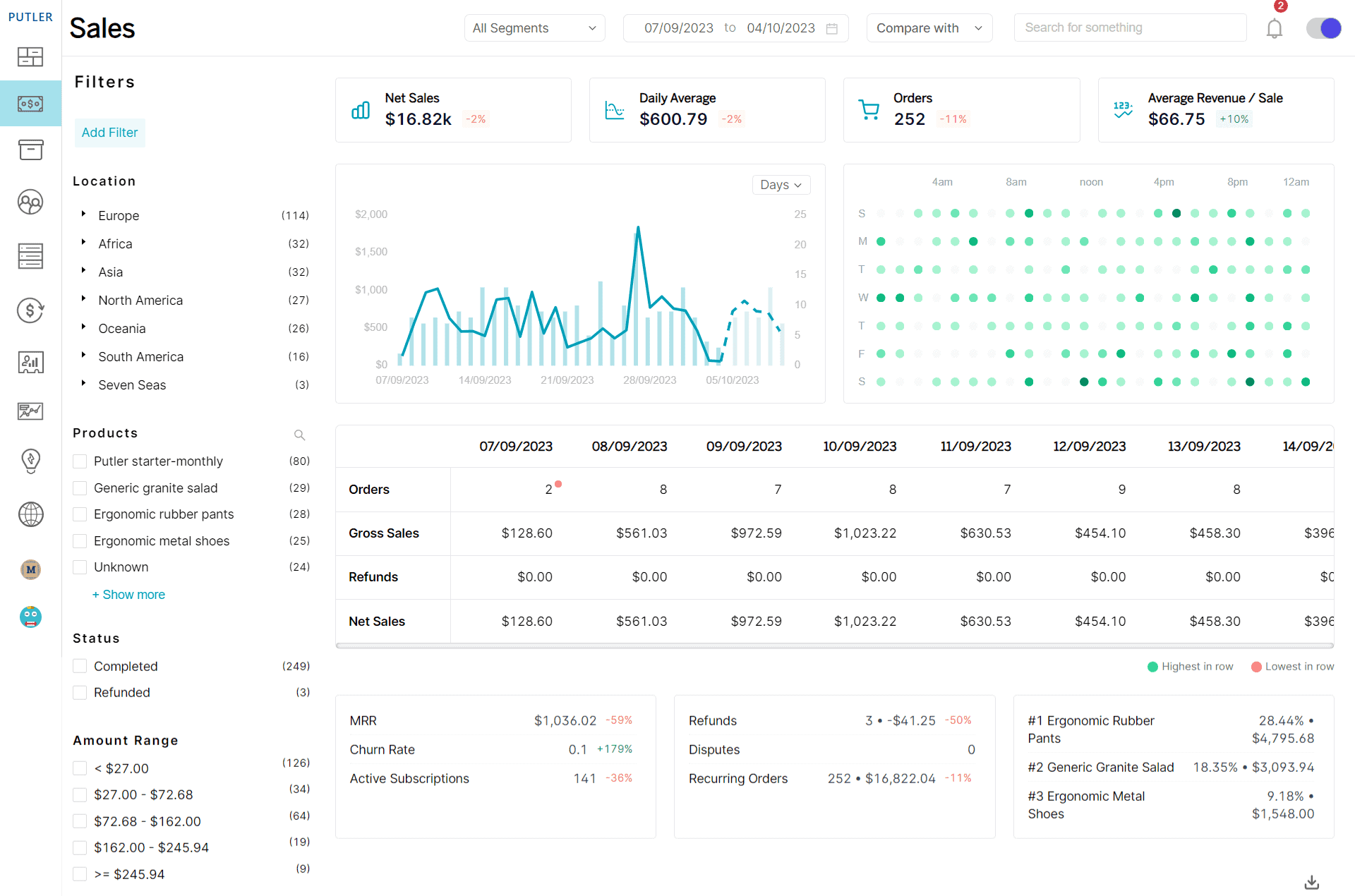
Let’s start with the key metrics for eCommerce, sales and revenue—the lifeboat of any eCommerce store.
Revenue
What it is: The total money your online store brings in from sales before any expenses come out. It’s like counting all the cash in your register at the end of the day.
How to calculate: Add up all customer payments over your chosen timeframe.
Revenue = Price × Quantity Sold
Why it matters: Without revenue, you don’t have a business; you have an expensive hobby.
Average Order Value (AOV)
What it is: How much money customers spend each time they hit the “buy” button on your store.
How to calculate:
AOV = Total Revenue ÷ Number of Orders
Why it matters: Increasing AOV lets you grow revenue without finding a single new customer.
Gross vs. Net Profit Margin
What it is: Gross margin is what’s left after product costs. Net margin is what actually goes in your pocket after all expenses.
How to calculate:
Gross Margin = ((Revenue - COGS) ÷ Revenue) × 100%
Net Margin = ((Revenue - All Expenses) ÷ Revenue) × 100%
Why it matters: High revenue with thin margins means you’re working hard for very little reward.
Sales Growth Rate
What it is: The percentage change in your sales compared to a previous time period.
How to calculate:
Sales Growth Rate = ((Sales in Current Period - Sales in Previous Period) ÷ Sales in Previous Period) × 100
Why it matters: It reveals whether you’re building momentum or slowly fading away.
Revenue Per Visitor (RPV)
What it is: The average amount of money each website visitor generates for your business.
How to calculate:
RPV = Total Revenue ÷ Total Number of Visitors
Why it matters: It combines traffic quality and conversion effectiveness into a single powerful metric.
Number of Transactions
What it is: The count of completed purchases in a given timeframe.
How to calculate: Count all completed orders in your selected period.
Why it matters: More transactions mean more opportunities to create loyal, repeat customers.
Tracking transactions is great, but what really powers growth is understanding the people behind those purchases—your customers.
Customer eCommerce metrics
Now it’s time to zoom in on the customer side of the equation. These metrics show how valuable your buyers really are, and how to keep them coming back.
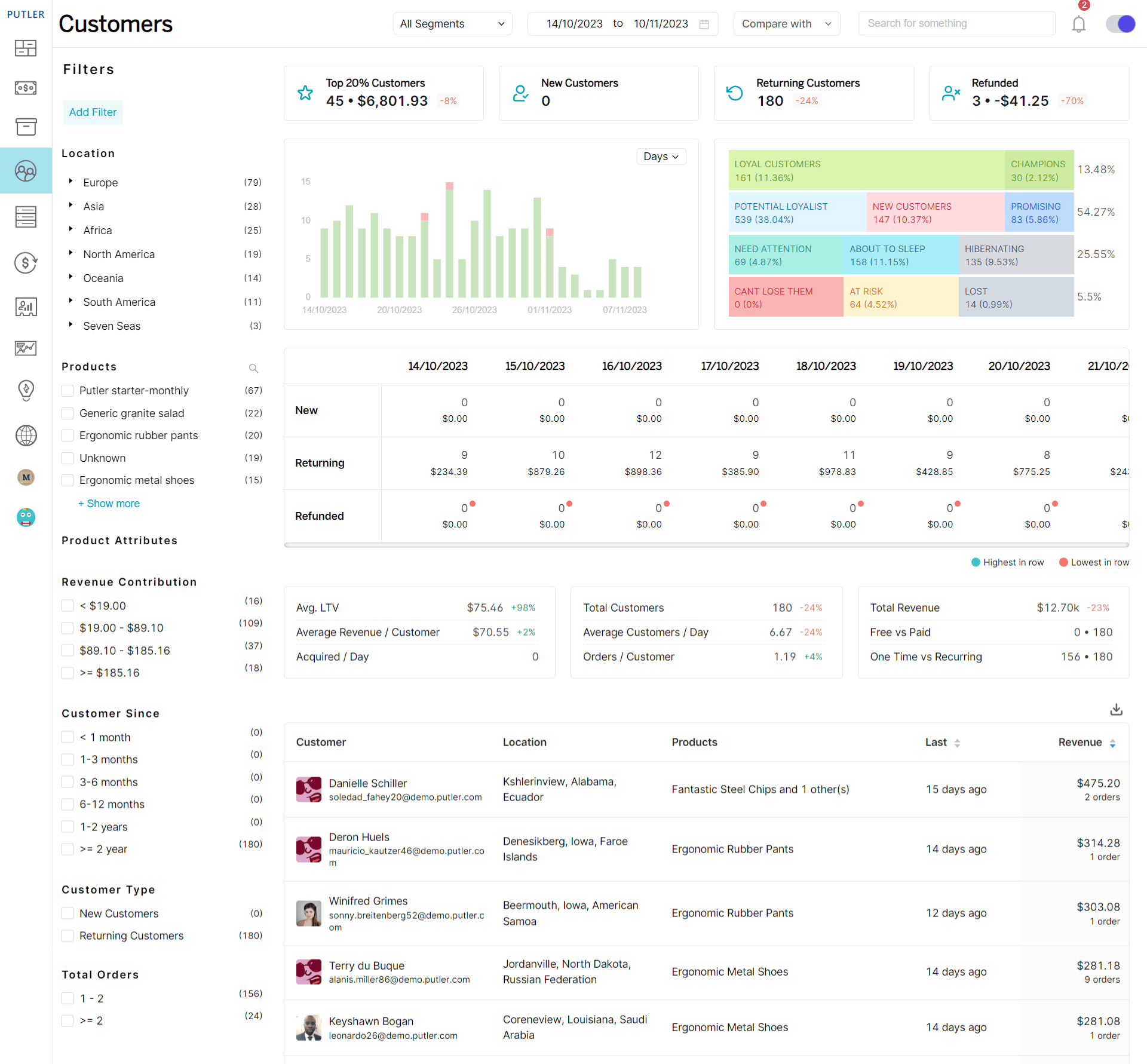
Customer Lifetime Value (CLV)
What it is: The total revenue you can expect from a customer during their entire relationship with your business.
How to calculate:
CLV = Average Order Value × Purchase Frequency × Average Customer Lifespan
Why it matters: It shows what a customer is truly worth beyond their first purchase, helping you invest wisely in acquisition and retention.
Customer Acquisition Cost (CAC)
What it is: The total cost of acquiring a new customer, including all marketing and sales expenses.
How to calculate:
CAC = Total Marketing & Sales Costs ÷ Number of New Customers Acquired
Why it matters: If it costs more to acquire customers than they spend, your business model is fundamentally broken.
Customer Retention Rate (CRR)
What it is: The percentage of customers who remain active buyers after a specific period.
How to calculate:
CRR = ((Customers at End of Period - New Customers) ÷ Customers at Start) × 100%
Why it matters: Increasing retention by just 5% can boost profits by 25-95% as repeat customers cost less to serve and spend more over time.
Churn Rate
What it is: The percentage of customers who stop buying from you during a specific period.
How to calculate:
Churn Rate = (Customers Lost During Period ÷ Customers at Start) × 100%
Why it matters: High churn undermines growth efforts—it’s like trying to fill a leaky bucket.
Returning Customer Rate vs. Repeat Purchase Rate (RPR)
What it is: Returning Customer Rate is the percentage of customers who come back to make additional purchases. RPR is the frequency of repeat purchases within a timeframe.
How to calculate:
Returning Customer Rate = (Number of Return Customers ÷ Total Customers) × 100%
RPR = Number of Repeat Orders ÷ Total Number of Orders
Why it matters: These metrics reveal if you’re building a loyal customer base or relying on constant new acquisitions.
Net Promoter Score (NPS) & Customer Satisfaction Score (CSAT)
What it is: NPS measures customer loyalty and likelihood to recommend. CSAT measures satisfaction with specific interactions.
How to calculate:
NPS = % of Promoters (9-10 scores) - % of Detractors (0-6 scores)
CSAT = (Number of Positive Responses ÷ Total Responses) × 100%
Why it matters: These are leading indicators of future purchase behavior and word-of-mouth growth.
Top Customers & Purchase Frequency
What it is: Top customers are your highest-value buyers based on spending, frequency, or recency. Purchase frequency is how often customers buy in a given timeframe.
How to calculate:
Purchase Frequency = Number of Orders ÷ Number of Unique Customers
Why it matters: The 80/20 rule often applies—20% of customers generate 80% of revenue. Identifying and nurturing these VIPs is crucial.
Now that I understand my customers better, it’s time to see how they find me and engage with my store.
Marketing & engagement eCommerce metrics
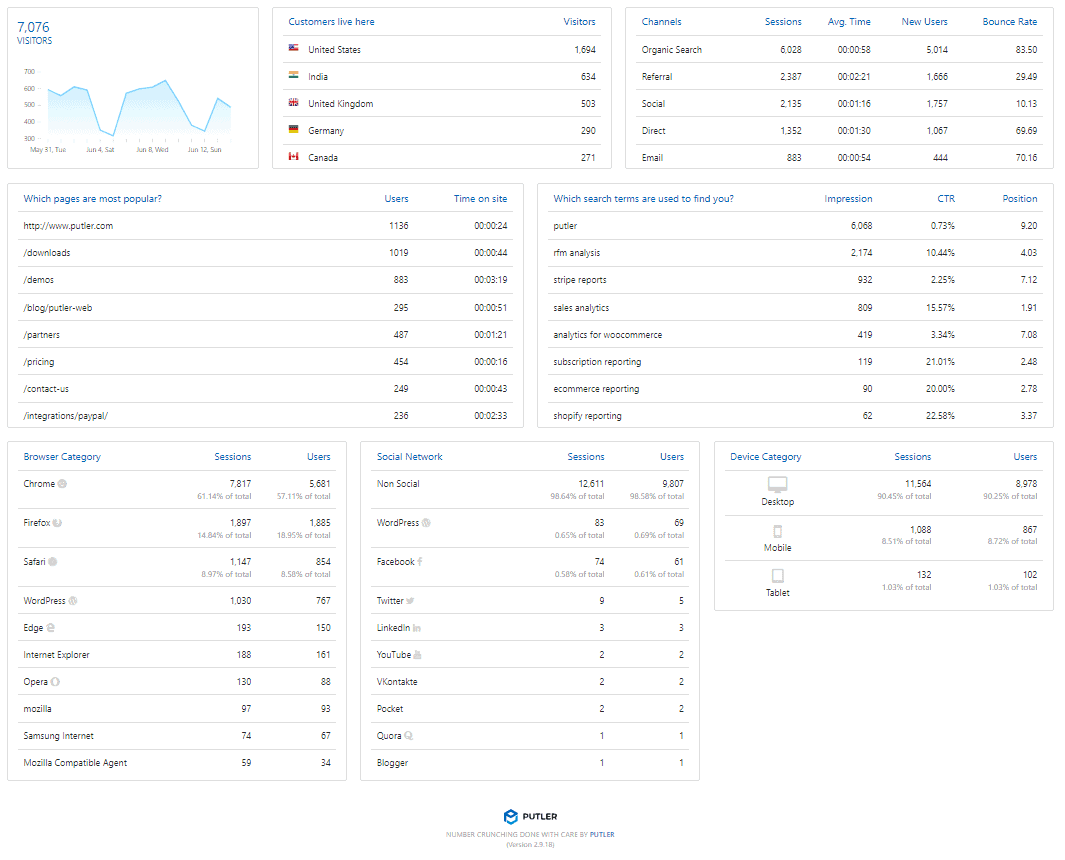
Let’s explore marketing and engagement metrics to track where my traffic comes from and how well my promotions are working.
Traffic Sources
What it is: The channels driving visitors to your store: direct (typing your URL), search (organic SEO), paid ads, referrals (links from other sites), and social media.
How to calculate: Track via Google Analytics, your platform’s eCommerce metrics dashboard, or Putler.
Why it matters: Reveals which channels deliver your most valuable traffic, helping you invest marketing budget effectively.
Click-Through Rate (CTR) & Cost Per Click (CPC)
What it is: CTR is the percentage of people who click your ad after seeing it. CPC is what you pay for each click.
How to calculate:
CTR = (Number of Clicks ÷ Number of Impressions) × 100%
CPC = Total Ad Spend ÷ Number of Clicks
Why it matters: CTR shows ad relevance and appeal; CPC determines your advertising efficiency and scalability.
Return on Ad Spend (ROAS)
What it is: The revenue generated for every dollar spent on advertising.
How to calculate:
ROAS = Revenue Attributed to Ads ÷ Cost of Ads
Why it matters: Directly shows if your ad campaigns are profitable or burning cash.
Email Open & Click Rates
What it is: Open rate is the percentage of recipients who open your email. Click rate is the percentage of users who click a link inside.
How to calculate:
Open Rate = (Number of Opens ÷ Number of Delivered Emails) × 100%
Click Rate = (Number of Clicks ÷ Number of Delivered Emails) × 100%
Why it matters: Indicates email relevance, engagement, and how effective your email subject lines are at driving traffic and sales.
Social Media Engagement
What it is: The level of interaction your content receives, likes, comments, shares, saves, and clicks.
How to calculate:
Engagement Rate = (Total Engagements ÷ Total Followers) × 100%
Why it matters: High engagement means your content resonates with your audience, and algorithms will show it to more people.
Impressions vs. Reach
What it is: Impressions are the total number of times your content is displayed. Reach is the number of unique users who see it.
How to calculate: Track via platform analytics (Facebook, Instagram, Google, etc.)
Why it matters: Impressions show content visibility; reach shows audience expansion. Both impact brand awareness.
With a clear view of how my audience interacts with my store, it’s time to focus on the products themselves and how well I manage inventory.
Website behavior & conversion eCommerce metrics
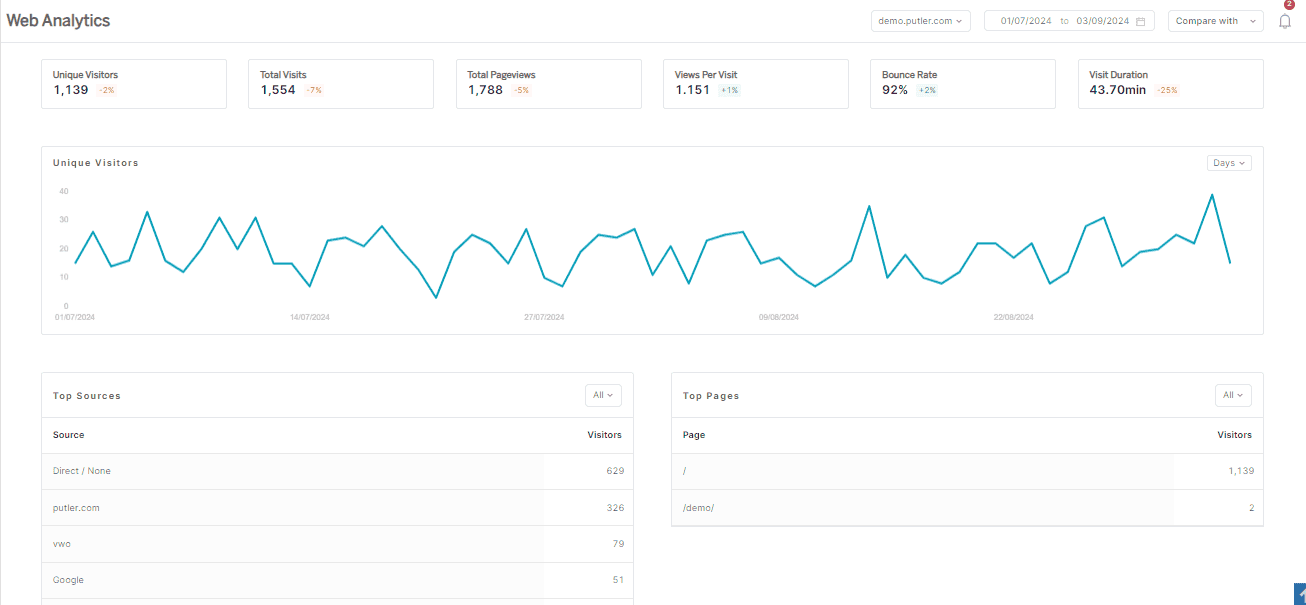
Let’s dig into website behavior and conversion metrics to see what’s driving visitors to buy, and where I might be losing them.
Top-Selling Products
What it is: The products that generate the most revenue or unit sales over a specific period.
How to calculate: Rank products by total revenue or units sold during your chosen timeframe.
Why it matters: Identifies what’s driving your business success and where to focus inventory and marketing resources.
Conversion Rate
What it is: The percentage of website visitors who complete a desired action, typically making a purchase.
How to calculate:
Conversion Rate = (Number of Conversions ÷ Total Visitors) × 100%
Why it matters: Directly shows how effectively your site turns browsers into buyers—small improvements here dramatically impact revenue.
Bounce Rate
What it is: The percentage of visitors who leave your site after viewing only one page without taking any action.
How to calculate:
Bounce Rate = (Single-Page Sessions ÷ Total Sessions) × 100%
Why it matters: High bounce rates indicate visitors aren’t finding what they need or your site isn’t engaging enough to explore further.
Average Session Duration
What it is: The average amount of time visitors spend on your site during a single visit.
How to calculate:
Average Session Duration = Total Duration of All Sessions ÷ Number of Sessions
Why it matters: Longer sessions typically indicate higher engagement and interest in your products or content.
Pages per Session
What it is: The average number of pages viewed during a single visit to your website.
How to calculate:
Pages per Session = Total Page Views ÷ Total Sessions
Why it matters: More pages viewed suggest deeper engagement and exploration of your site, and visitors are actually interested in what you offer.
Cart Abandonment Rate
What it is: The percentage of shoppers who add items to their cart but leave without completing the purchase.
How to calculate:
Cart Abandonment Rate = (Abandoned Carts ÷ Total Carts Created) × 100%
Why it matters: Represents nearly-converted customers and significant recoverable revenue. These shoppers showed high purchase intent.
The truth is, you don’t need every metric under the sun. If you run an eCommerce store, Putler is the shortcut to what matters.
Product & inventory eCommerce metrics
Now, I’ll dive into product and inventory metrics to make sure my stock is moving efficiently and not sitting idle.
Inventory Turnover Ratio
What it is: How many times your entire inventory is sold and replaced during a specific period.
How to calculate:
Inventory Turnover = Cost of Goods Sold ÷ Average Inventory Value
Why it matters: Shows how efficiently you’re managing inventory, higher turnover usually means better cash flow and less capital tied up in stock.
Stock-Out Rate
What it is: The percentage of time your products are unavailable for purchase due to being out of stock.
How to calculate:
Stock-Out Rate = (Number of Days Item Out of Stock ÷ Total Number of Days) × 100%
Why it matters: Stock-outs mean lost sales, frustrated customers, and long-term brand damage if habitual.
Sell-Through Rate
What it is: The percentage of inventory received that actually sells within a specific timeframe.
How to calculate:
Sell-Through Rate = (Number of Units Sold ÷ Number of Units Received) × 100%
Why it matters: It reveals how quickly products are selling compared to your purchasing pace, which is key for seasonal and trend-based products.
Product Return Rate
What it is: The percentage of items sold that are returned by customers.
How to calculate:
Return Rate = (Number of Units Returned ÷ Number of Units Sold) × 100%
Why it matters: High return rates destroy profits through shipping costs, processing labor, inventory depreciation, and customer service expenses.
Product Margin
What it is: The profit made on each product after accounting for the cost of goods sold.
How to calculate:
Product Margin = (Sales Price - Cost) ÷ Sales Price × 100%
Why it matters: Helps identify which products contribute most to your bottom line beyond just looking at revenue.
With my products and inventory in check, the next step is to understand how visitors behave on my site and turn into customers.
How Putler helps me track everything in one place
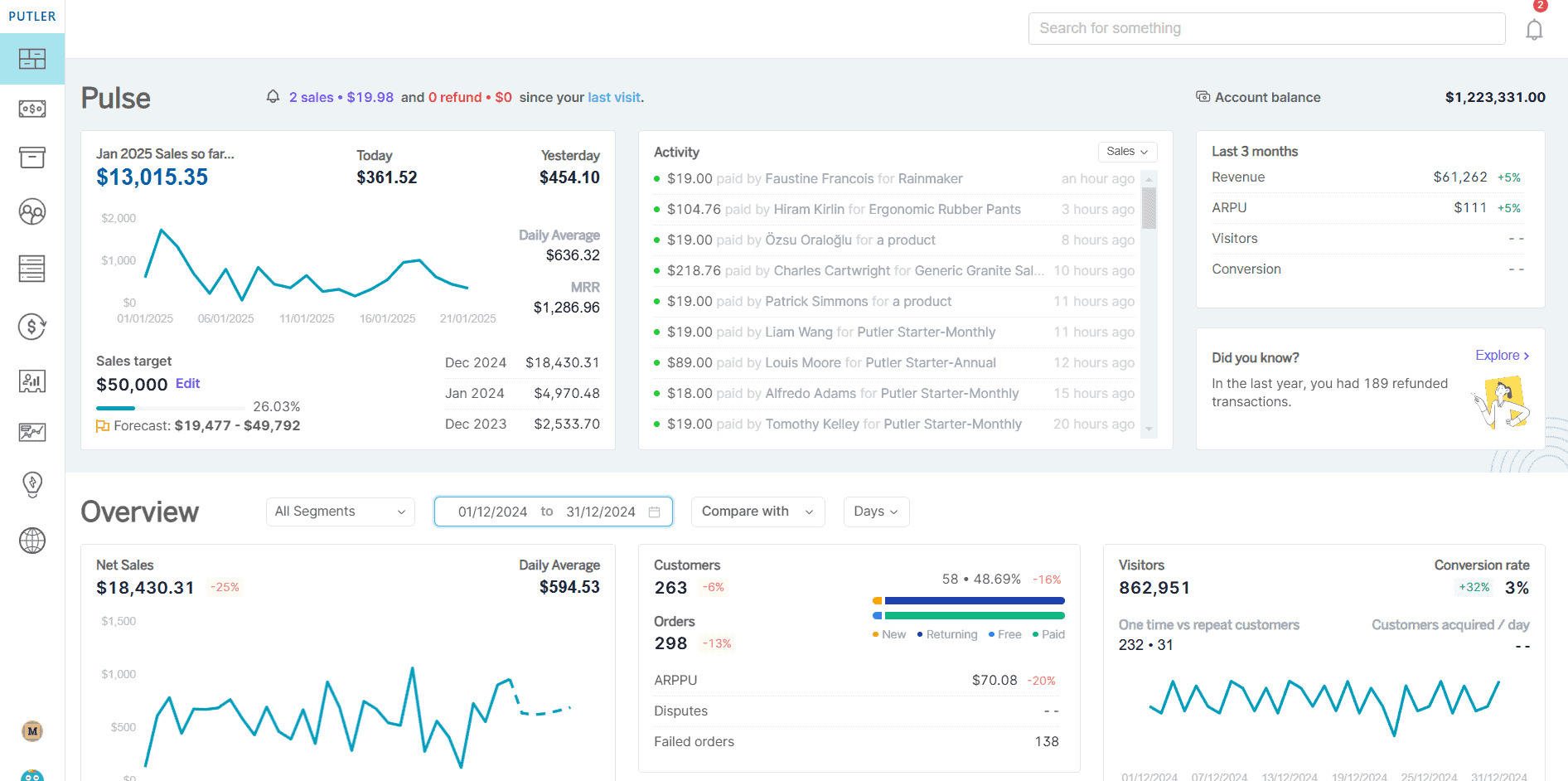
You know that frantic morning routine of jumping between six different platforms just to see how your store performed? Yeah, I’ve been there. Putler basically became my business remote control – one dashboard that pulls everything together.
Unified dashboard across stores, platforms, and payment gateways
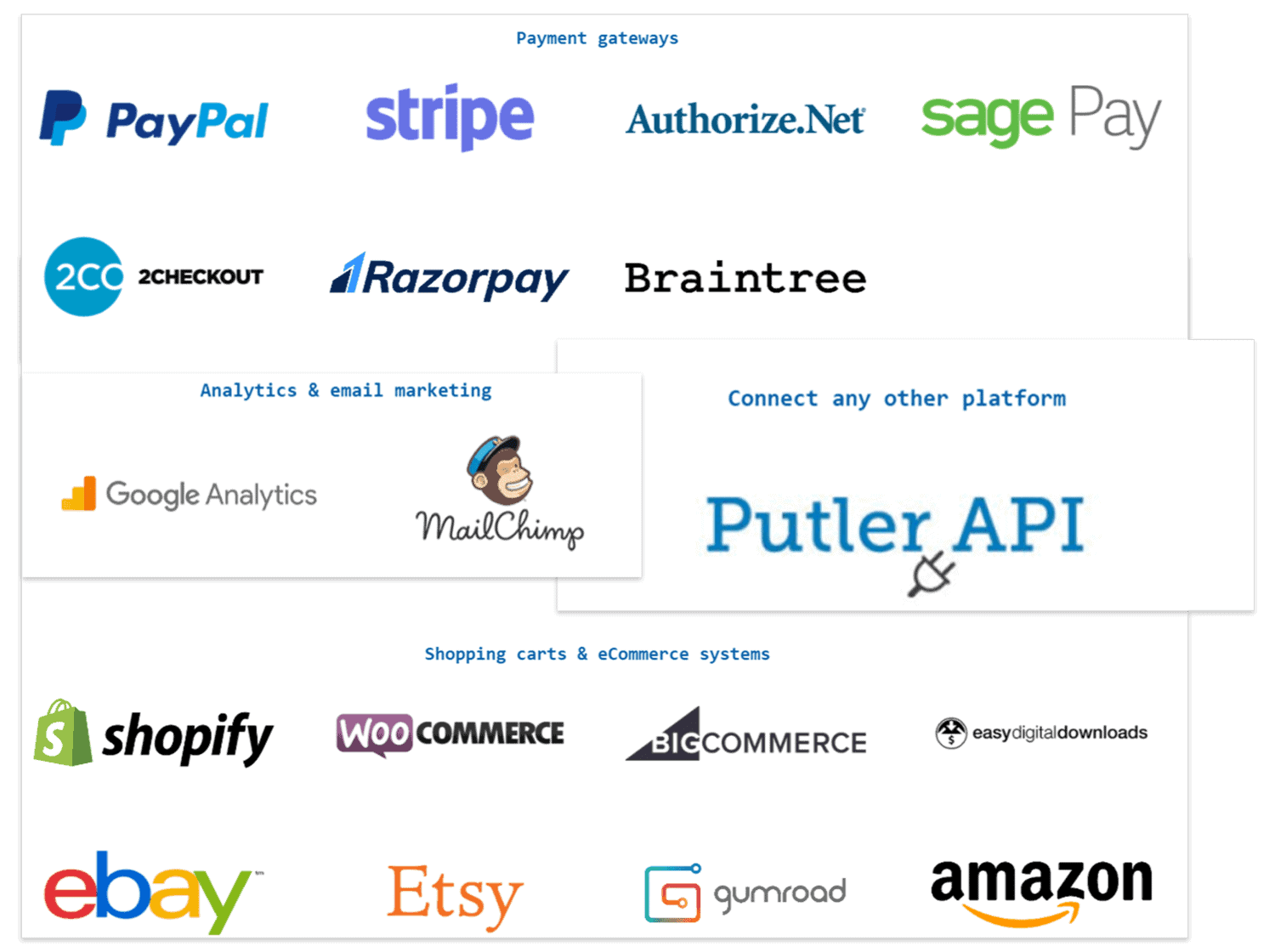
All my Sales channels in one view:
- Storefronts: Shopify, WooCommerce, Amazon, eBay, Etsy and more
- Payment gateways: PayPal, Stripe, Braintree and more
- Analytics & marketing Tools: Google Analytics, MailChimp and more
The best part? Putler automatically fixes those annoying data headaches – duplicate transactions, currency conversions, timezone chaos. No more manual cleanup.
Ready-made reports (200+ metrics)
The Putler team basically did the homework. With over a decade in eCommerce, they built all the eCommerce metrics and KPIs I actually need and organizes them into different dashboards.
- Sales performance dashboards
- Customer insights dashboard
- Product performance dashboard
- Subscription analysis dashboard
- Audience behaviour dashboard
- Website performance dashboard
- Holiday insight dashboard
And more.
Zero-setup customer intelligence
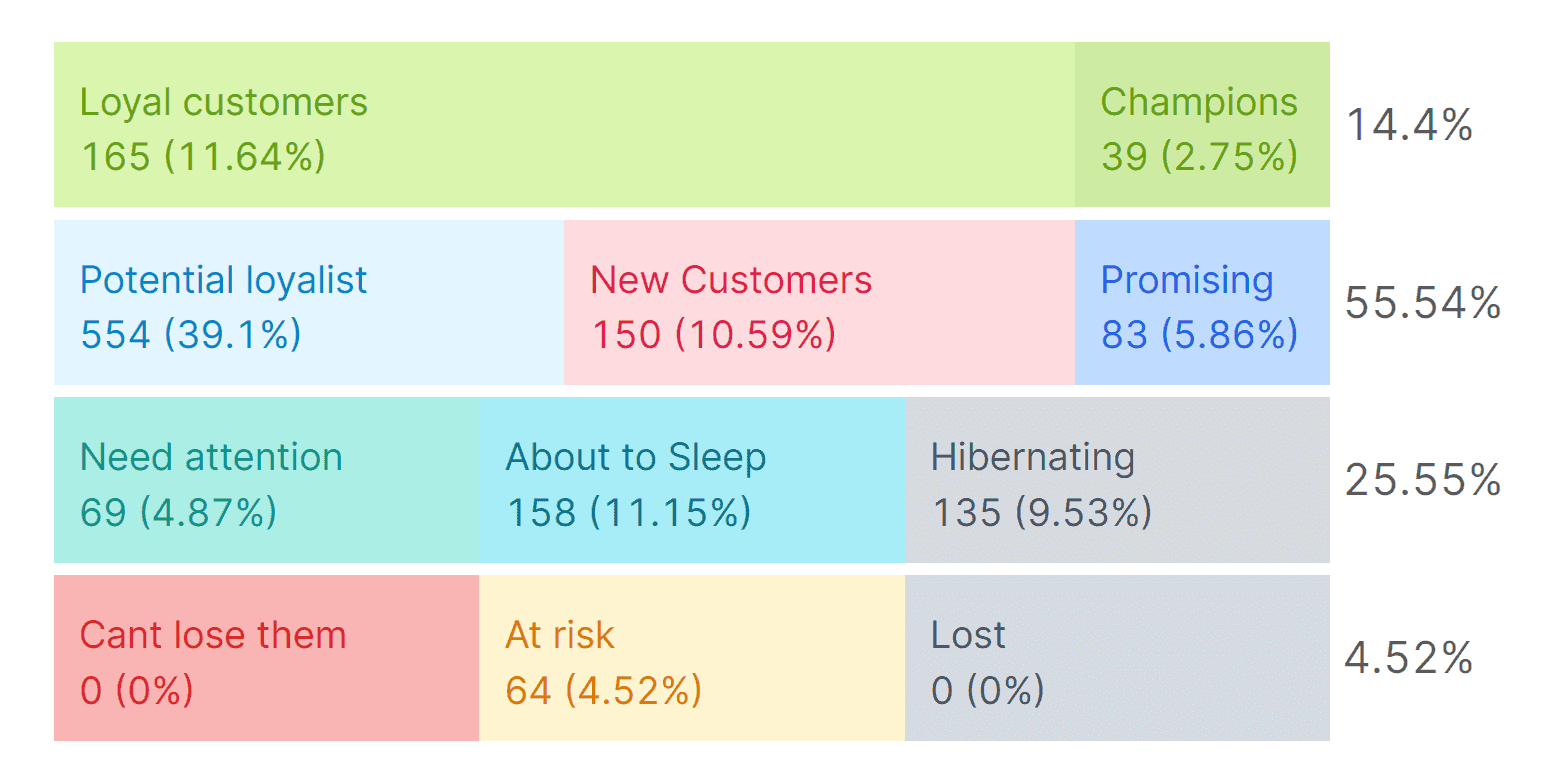
This is where it gets really cool. From day one, Putler automatically:
- Segments my customers: Champions, Loyal, At-Risk, New
- Creates custom filters: Location + spending + Quantity sold
- Identify peak activity time: Visual representation, Heatmap
- Delivers instant insights: No coding, no waiting weeks
Real use cases:
- “Show me California customers who spent $100+ in Q4” – takes 10 seconds
- “Which products are my Champions buying repeatedly?” – instant report
- “Who are my at-risk customers that need a win-back email?” – automatic list
Instead of drowning in spreadsheets, I’m actually using my data to make smarter decisions. It’s like having a data analyst who speaks plain English.
Conclusion
Now that your business goals and KPIs are set, it’s time to take action and keep moving forward.
Make sure to organize all your eCommerce KPI data in one place and keep it updated regularly to stay on top of things.
You’re not just running a business, you’re steering it to success by keeping a close eye on your KPIs. Let your data guide smarter decisions and better results.
If you ever need a hand with managing your KPIs, Putler’s insights and analytics are there to help you grow.
Use your data to find new opportunities and push your business forward. There’s so much potential ahead!
FAQs
What metrics does Shopify use?
Shopify tracks metrics like Total Sales, Average Order Value (AOV), Conversion Rate, Cart Abandonment Rate, and Customer Lifetime Value (CLV) to help monitor store performance and customer behavior.
What are the metrics for B2C e-commerce?
Key B2C e-commerce metrics include Revenue, AOV, Conversion Rate, Customer Acquisition Cost (CAC), CLV, Cart Abandonment Rate, and ROAS, which help in understanding sales, customer behavior, and marketing effectiveness.
How often should I check my eCommerce metrics?
Check key metrics like sales, traffic, and conversion rates daily or weekly. Metrics like CLV and CAC can be reviewed monthly or quarterly for long-term insights and adjustments.
